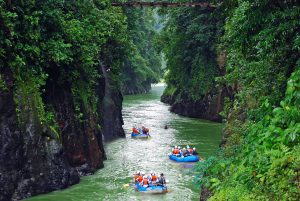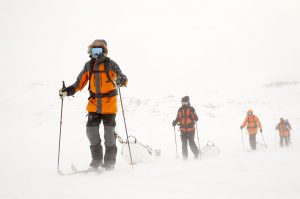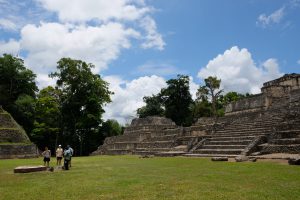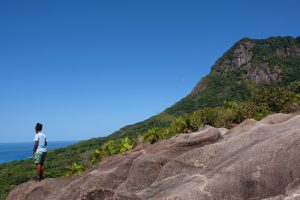
Mayan ruins, powdery beaches and jungle sinkholes are among the highlights of Mexico’s southern peninsula. Amelia Duggan explores.
View online at worldwidedestinationguide.com
It’s impossible to rush the Yucatan. The official pace of life here is a blissed-out amble, coaxing travelers to set aside their worries with every step. Mexico’s fabled southern peninsula has been known to muddle visitors’ sense of time: in this laid-back, sun-soaked land, a weekend trip can feel like a month. And you’d need a month — with attractive colonial cities, world-famous Mayan ruins, vibrant nightlife centers, sunken freshwater cenotes (swimming holes) and powdery beaches spread thickly along a turquoise coast dotted with palm-fringed islands, there’s plenty to explore.
The peninsula juts into the Gulf of Mexico, encompassing the forested, lowland states of Yucatan, Quintana Roo and Campeche — a collective blessed with year-round warmth, although temperatures become milder during the rainy season (May to October). The largest — and perhaps most classically beautiful — city is Merida in the north west, but the hubs of colonial Valladolid (gateway to Chichen Itza, dating from 600BC) and glitzy Cancun (home to the region’s largest airport) have their charms.
Stretching south from Cancun, past the party hotspot of Playa del Carmen, to the barefoot paradise of Tulum is the so-called Riviera Maya: a touristy stretch of resorts. It’s a great place to sip a mojito on a sun lounger, but more authentic experiences await on lesser-visited islands and quieter, bohemian beach spots.
DAY 1
Morning: Cancun’s glitzy hotel district might be the place to dance the night away, but the gleaming high-rises aren’t for everyone. Check out the interactive aquarium, then drive 83 miles up to Chiquila and get the ferry to Isla Holbox, an uncommercialized stretch of heaven.
Afternoon: Isla Holbox is famous for its dolphins and whale sharks — between the months of June and September, hop aboard a tour boat and go swimming with these gentle giants. Also available are diving tours and kitesurfing lessons. Alternatively, explore the island’s villages by golf buggy or take off to remote, uninhabited beaches on foot.
Evening: Island life is all about relaxation. Enjoy an evening meal of fresh ceviche (raw fish marinated in lime, with diced tomatoes, hot peppers, red onion, cilantro and salt) and take in a burning, tangerine sunset from a hammock, tequila cocktail in hand.
DAY 2
Morning: Back on the mainland, drive 124 miles to Chichen Itza. Sure, you’re never going to have the popular Maya site to yourself but there’s a reason it was declared one of the New Seven Wonders of the World. From the imposing, monolithic El Castillo pyramid to the Sacred Cenote and curiously designed El Caracol, you don’t have to be an archaeologist to enjoy this man-made marvel.
Afternoon: The Yucatan is peppered with fabulous sunken swimming holes; just 25 miles from Chichen Itza are Cenotes Samula and X’quequen — postcard-perfect caverns with alamo roots trailing down from the upper rims to icy blue pools below. The pair are close to the city of Valladolid, so consider renting bicycles here and pedalling out to them.
Evening: Back in provincial Valladolid, explore the pastel-splashed streets and check out the lovingly restored Templo de San Bernado and adjacent Convento de Sisal, a fortress and monastic complex built by the Spanish in the 16th century, featuring dusky terraces and rooms, carved altars, elegant courtyards and even an underground river. A free evening light show tells the buildings’ story through a short but stunning al fresco projection.
DAY 3
Morning: In Mayan times, Tulum had a different name: Zama, which means ‘City of Dawn’, named for its east-facing beaches that catch the first rays. Grab a fruit smoothie from one of the strip’s boho cafes and then explore the area’s ruins; the temples, palaces and castles of the 15th-century walled city sit on or near bluffs overlooking the Caribbean Sea.
Afternoon: There are a number of organised tours from Tulum to coastal wetland the Sian-Ka’an Biosphere Reserve, a UNESCO World Heritage Site, where canopy walks, kayaking in jade lagoons or 4WD rides through the rainforest are all options. Head out on a half-day tour of the Muyil area to sample mangrove forests and remoter ruins.
Evening: A temazcal ceremony is a memorable full-body experience with its roots in ancient spiritual and medicinal rituals. Shop around in Tulum; a proper ceremony should last at least three hours and include a purifying ritual of burning copal (a sacred tree), and guided meditations in a haze of fragrant steam within a clay hut.
Where to stay
Palapas Del Sol, Isla Holbox
This colourful boutique hotel has sea-facing balconies or decks attached to each room. The food is superb and it’s tucked away from the main town, right on a quiet stretch of shore with plenty of hammocks. palapasdelsol.com
Papaya Playa, Tulum
Bordering the forested Quintana Roo National Park, this eco-chic cabin and cottage retreat on Playa Pescadores lies four miles from Tulum town centre. papayaplaya.com
Azul Beach Hotel by Karisma, Cancun
The all-inclusive resort boasts 148 guest rooms and suites in low-rise adobe buildings clustered along the water’s edge. The only disturbance here will be a beach butler asking if you’d like a cool drink from the tequila lounge. karismahotels.com
How to get there
Flights
Flight time from Miami to Mexico is 1.5 hours. Most major US airlines fly to Cancun International Airport (Mexico’s second busiest airport after Mexico City, but the biggest for international visitors). Mexico’s flag carrier Aeromexico offers frequent deals and offers.
Visas
US citizens don’t need a visa to enter Mexico. US citizens traveling by air will need a passport, while those traveling by land or sea can enter Mexico and return to the US with a passport card. US dollars widely accepted in tourist areas, as well as major credit cards. visitmexico.com
Transport
While Mexico City has an extensive bus and trolleybus service, a tramway network and an inexpensive, efficient metro system, renting a car on arrival at the airport in Cancun is recommended. The safest taxis to use are orange, metered Sitios, and Turismo taxis, with English-speaking drivers, found outside hotels or taxi stations. Fares should be agreed in advance for both.
Published in ASTA Network Summer 2016














